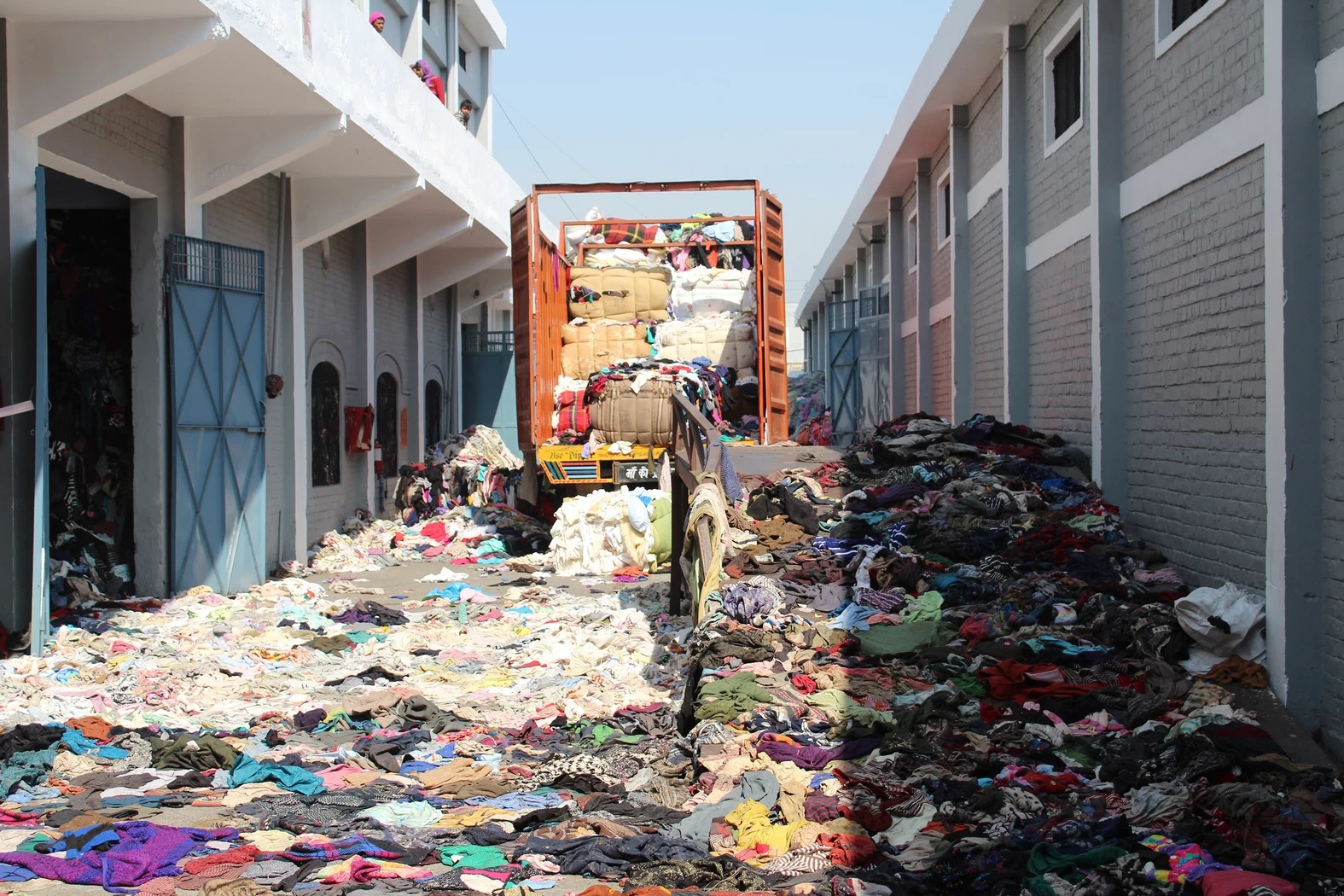How can we fix fashion? Not only has the industry had its ethical demons come to light in the last few years – accusations of sexual abuse, racism, sexism, ageism – it’s also one of the biggest polluters in the world. Every year, the apparel industry produces 100 to 150 billion items (there are only about 7 billion people in the world) and out of all that stuff, we then find out that fashion brands end up destroying billions of pounds worth of it. We’re not talking fast fashion juggernauts. We’re talking ‘luxury’, the term used to sell us something that will last a lifetime. It turns out it’s just as disposable as everything else we buy.
The truth is that fashion is innately the existential antithesis of sustainability. If there was any doubt, here are the facts. At today’s pace, the textiles economy is projected to release over 20 million tonnes of plastic micro-fibres into the ocean by 2050. By 2030, it is predicted that we will be using two Earths’ worth of resources and the demand for clothing is expected to have risen by 63 per cent.
Currently, some 87 per cent of the 53 million tonnes of clothing produced globally each year is either incinerated or dumped into landfills. At present, less than 1 per cent of the materials used to create clothing are recycled into new clothing, according to a 2017 study by the Ellen MacArthur Foundation, an organisation dedicated to encouraging the adoption of a circular economy.
How, we must ask ourselves, do these environmental massacres correlate with the values of luxury? How are luxury brands so far behind when it comes to tapping into the eco-zeitgeist? And most importantly, how have they completely lost sense of what luxury even means? Earlier this year, an eagle-eyed reporter noticed that Burberry had destroyed almost £30 million of clothes, bags, perfumes, shoes: the very things that glide down the catwalk and into its polished boutiques. Cue the outcry that a luxury brand would commit such an act of pollution. The real problem of course, isn’t Burberry, it’s that Burberry isn’t alone. Burning dead stock is one of fashion’s open secrets. In the last few years, Richemont – which owns Cartier, Alaïa and Chloé – as well as Céline and Chanel have all been criticised for destroying millions of pounds worth of dead stock; Bond Street might not be so dissimilar to ‘Made in Bangladesh’.
“87 per cent of the 53 million tonnes of clothing produced globally each year is either incinerated or dumped into landfills.”
Every major fashion house is either doing it or has done it. Why? Because luxury houses are built on scarcity, rarity and the all-important prerequisite of exclusivity. Cut-price products in sales are bad enough; if they don’t sell after that stage, they’ll either get discounted so much they’ll be as cheap as fast fashion or they’ll flood basement bins. Finding too much of a luxury label in TK Maxx ends up diluting brand equity.
Plus, if ‘luxury’ products become too accessible, they can easily fall into the hands of counterfeiters. The £450 million black market isn’t just illegal – it results in vulnerable people and undocumented immigrants being exploited for low-cost labour. The profits from which may fund organised crime and the trafficking of weapons, drugs and people.
Yet burning product – much of which isn’t biodegradable (all those zips, synthetic fabrics and plastic buttons) – is certainly not the answer. It is a practise that speaks of wider systemic concerns within the fashion industry. The fear of what is described as ‘sheet business’, for instance. Think about it: who in their right mind buys bedsheets full-price? Any bargain-hunter knows that you can always get linens for less. The same applies to a T-shirt or a designer’s signature non-seasonal dress.
Seasonal products – novelty accessories, time-sensitive branding, distinctive visual motifs – can’t flood the discount rails because it gives the impression of a brand that no one’s buying. It’s a smoke-and-mirrors strategy designed to give luxury brands the glossy veneer of impenetrable clout and aspirational desirability, and to encourage conspicuous consumption.
The public shock at the practice of burning these products speaks to a cultural shift within the world of luxury, which has been at a crossroads since the boom of e-commerce, social media and mid-market brands. Officially coined as an adjective in 1930, the etymology of the word ‘luxury’ has a prophetic sense of what it would come to mean in the 21st century. ‘Luxury’ takes its name from the Latin word ‘luxus’, which translates to ‘excess’, via the 12 th century French word ‘luxurie’, which referred to sinful self-indulgence and lecherous lust.
“At today’s pace, the textiles economy is projected to release over 20 million tonnes of plastic micro-fibres into the ocean by 2050. By 2030, it is predicted that we will be using two Earths’ worth of resources and the demand for clothing is expected to have risen by 63 per cent.”
Today, the word ‘luxury’ is used to describe everything from apartments in Tottenham to Tesco sausages. Many people assume that it’s synonymous with other bastardised words like ‘craftsmanship’, which more often than not refers to the fetishisation of Caucasian factory workers; or ‘heritage’, which simply means the name of the dead person being used to shift mediocre product.
What luxury should mean is something rare, bespoke and considered in both production and design. Sometime in the 80s, though, luxury brands became big business and fashion went global. Boutique openings in Dubai. Lipstick launches in Beijing. Trunk shows in Moscow. It was probably then that copious fragrances, cosmetics and sunglasses started to form the swelling of revenues for the world’s biggest fashion houses. What didn’t sell was quite literally burnt at the temple of Mammon.
Now, before this gets too gloomy – perhaps it’s too late? – it’s important to remember that it’s not all akin to the firepits of handbags in hell. There are luxury houses that do the word justice. At Hermès, for instance, everything is made by hand, which means that the brand has control over its supply chain and makes a finite number of products per year – hence the notorious waiting lists. The French brand also has an initiative called ‘petit H’ that sees artisans turns scraps of fabric and leather into small goods, which is both clever and chic.

A younger generation of fashion designers, too, are not only tapping into sustainable methods of production, they’re making it sexy. Richard Malone is known for his bright, sculptural womenswear, but what isn’t so obvious is that the materials he uses are often recycled fabrics made from ocean waste, fishing nets, plastic bottles and acrylics from old school uniforms into cleverly cut knits that couldn’t be further from the stereotypically assumed look of ‘green’ fashion. He’s also worked with a community of female weavers in Tamil Nadu, India, for a while, commissioning them to make the bright, non-polluting colours that are dyed naturally, and with low water consumption – not that you would be able to tell by the saturated hues in his collections. And Richard is just one example of a new generation of young designers, who implicitly and innovatively make clothes with one eye on environmental concerns.
But when has an ethical high ground ever come in the way of someone on a mission to look good? We’re much more likely to be concerned with how our bums look in clothes than what they’re made from. That’s why Malone’s clothes are brilliantly attuned to the realities of women’s lives – sweeping coats with sculptural shoulders, high-waisted kick-flare trousers, fluid tailoring and criss-cross knit dresses are not only made to last, by hand, but are conveniently machine-washable.
“We’ve moved so far from what fashion is. The change has been ridiculous in the last 20 years,” Richard says. “For me, it’s just about making a product that is functional and not at a level of productivity that is not realistic. We couldn’t afford to make the clothes with factories so we made it in-house. That’s what the customers want; they’re smart – they can see past marketing and branding.”
“The billion-dollar question: What is the solution here? For many brands, it’s the circular economy, a term that refers to a value ‘circle’ where products and materials are recovered, regenerated and reused.”
The Irish designer previously worked at a number of luxury houses, where he saw first-hand the incineration of exotic skins and deadstock fabrics. “Working with some of these [luxury] companies, the quality isn’t much different to the high street,” he points out. “It’s the quantity that’s different. The product is the same, but it’s 2,000 dresses instead of 200,000 dresses.”
Which brings us back to the billion-dollar question: What is the solution here? For many brands, it’s the circular economy, a term that refers to a value ‘circle’ where products and materials are recovered, regenerated and reused. It is an alternative to a product’s traditional linearity – make, use, dispose. At the Copenhagen Fashion Summit last year, H&M, Stella McCartney, Nike and funnily enough, Burberry, spoke of making the make-use-dispose model of apparel obsolete. H&M even announced an impressive commitment to be completely circular and renewable by 2030.
“Fortunately, through transparency, technology and customer awareness, the landscape is changing,” says fashion consultant Julie Gilhart, who was formerly the fashion director of Barneys New York and has been a long-time advocate for sustainability issues. She points out that 77 per cent of millennials prefer to buy from environmentally-friendly brands, but practical considerations around price and aesthetics can’t be ignored either.
It also requires a widespread embrace of the resale market, which has been growing with the rise of companies such as The RealReal and Vestiaire Collective, which offer verified second-hand designer clothes and luxury goods in the same format as Net-a-Porter. In April, Stella McCartney – fashion’s Boudicca on a cruelty-free chariot, always ahead of the curve – launched a partnership with The RealReal that tapped into the circular economy. The idea is that when you upload a Stella McCartney product to the resale platform, you earn an £100 voucher to spend on something new from the designer. It’s relatively simple, but unequivocally genius.
“It’s a fully circular way of cleaning and restoring one’s closet,” explains Gilhart. “Stella has strongly encouraged people to resell her clothes to consignment businesses like The RealReal so that they stay out of landfills and retain their value longer.”

What is clear is that the fashion industry is still in service to consumers, many of whom value price, novelty, quality and design more than they value the ethical considerations of their purchasing decisions. You only have to look at the voracious appetite for fast fashion e-tailers such as Boohoo, Miss Guided and ASOS to see that a younger generation will always go for low-price product instead of meaningfully designed, manufactured and recycled alternatives – especially if they know that ‘luxury’ brands are just as disposable as fast fashion.
It’s now up to the brands themselves, especially aspirational ones, to set the benchmark of what is truly luxurious – something with pride-worthy provenance, considered design and several lifespans ahead of it.
This article originally appeared in i-D’s The Earthwise Issue, no. 353, Fall 2018.





